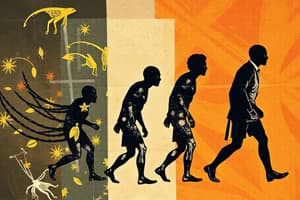Podcast
Questions and Answers
Considering Thompson's four-allele theory, which of the following genotypes would NOT be possible in the offspring of an A2B individual and an O individual?
Considering Thompson's four-allele theory, which of the following genotypes would NOT be possible in the offspring of an A2B individual and an O individual?
- A1O (correct)
- A2O
- OO
- BO
Flashcards
Thompson's four-allele theory
Thompson's four-allele theory
A theory proposing four alleles: A1, A2, B, and O, responsible for blood type inheritance.
Six phenotypes
Six phenotypes
The six observable blood types resulting from the four allelic genes: A1, A2, B, O, AB, A2B.
Ten possible genotypes
Ten possible genotypes
The genetic combinations possible from the inheritance of the four alleles, which lead to various phenotypes.
Cis-AB condition
Cis-AB condition
Signup and view all the flashcards
Codominance
Codominance
Signup and view all the flashcards
Study Notes
Thompson's Four-Allele Theory of Inheritance
- Thompson proposed a four-allele theory in 1930, based on 1911 von Dungern and Hirszfeld's discovery of A antigen subgroups (A1 and A2).
- The theory includes four alleles: Al, A2, B, and O.
- These four alleles produce six phenotypes: Al, A2, B, O, A1B, and A2B.
- Each individual inherits two genes for each characteristic (one from each parent).
- The four alleles result in ten possible genotypes.
- In typical AB group individuals, the A and B genes reside on separate chromosomes, exhibiting codominance.
- A rare condition, Cis-AB, exists where both A and B alleles are inherited from the same parent.
- Individuals with Cis-AB have a weaker B antigen and anti-B antibodies in their serum.
- Table 2.4 presents six possible genotype pairings (one phenotype) in matings, along with their potential offspring phenotypes.
Studying That Suits You
Use AI to generate personalized quizzes and flashcards to suit your learning preferences.




